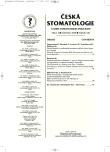Fibrous Dysplasia in a Child Patient Treated with Bisphosphonates
Authors:
R. Hodan 1; R. Čermáková 2; J. Syrovátka 1
; P. Širůček 3
Authors‘ workplace:
Klinika ústní, čelistní a obličejové chirurgie FN Ostrava
1; Klinika dětského lékařství FN Ostrava
2; Klinika nukleární medicíny FN Ostrava
3
Published in:
Česká stomatologie / Praktické zubní lékařství, ročník 108, 2008, 4, s. 48-52
Category:
Overview
The main property of bisphosphonates is inhibition of maturation and migration of osteoclasts resulting in decrease bone resorption. This property has been often used in the therapy of bone diseases such as osteoporosis, Paget’s disease, or as a part of multiple myeloma or osteolytic metastases treatment.
The authors describe the application of the property of bisphosphonates to inhibit bone resorption in the therapy of fibrous dysplasia of lower jaw in a 15-year girl. The treatment used an oral form of alendronate. The course of the disease is documented by scintigraphy images. The fibrous dysplasia has not disappeared completely, but there was a substantial decrease in metabolic activity of the lesion which prevented a superfluous enlargement of the focus and development of deformity of lower jaw.
Key words:
fibrous dysplasia – bisphosphonates – osteoclasts – osteoporosis – scintigraphy
Sources
1 Albright, F., Butler, A. M., Hampton, A. O., Smith, P.: Syndrome characterized by osteitis fibrosa disseminata, areas of pigmentation and endocrine dysfunctions, with precocious puberty in females. N. Engl. J. Med., 216, 1937, s. 727–746.
2. Bell, N. H., Avery, S., Johnston, C. C. Jr: Effects of calcitonin in Paget’s disease and polyostotic fibrous dysplasia. J. Clin. Endocrinol. Metab., 31, 1970, s. 283–290.
3. DiCaprio, M. R., Enneking, W. F.: Fibrous dysplasia: patophysiology, evaluation, and treatment Journal of Bone and Joint Surgery. (American volume). Boston: Aug 2005.Vol.87, Iss. 8; pg. 1848, 17 pgs.
4. Glorieux, F. H., Bishop, N. J., Plotkin, H., Chabot, G., Lanou, G., Travers, R.: Cyclic administration of pamidronate in children with severe osteogenesis imperfecta. N. Engl. J. Med., 339, 1998, s. 947–952.
5. Hansen, T., Kukel, M., Weber, A., Kirkpatrick J.: Osteonecrosis of the jaws in patients treated with bisphosphonates - histomorphologic analysis in comparison with infected osteoradionecrosis.[Article] Journal of Oral Pathology & Medicíně, 35, 2006, 3, s. 155-160.
6. Chapurlat, R. D., Delmas, P. D., Liens, P. J.: Long-term effects of intravenous pamidronate in fibrous dysplasia of bone. J. Bone Miner Res., 12, 1997, s. 1746–1752.
7. Lane, J. M., Khan, S. N., O’Connor, W. J., Nydick Hommen, J. P., Schneider, R., Tomin, E., Brand Kurtin, J.: Bisphosphonate therapy in fibrous dysplasia. Clin. Orthop., 2001, s. 6–12.
8. Lane, J. M., Khan, S. N., O’Connor, W. J., Nydick, M., Hommen, J. R. Schneider, R., Tomin, E., Brand, J., Kurtin, J.: Bisphosphonate therapy in fibrous dysplasia. Clin. Orthop. Relat. Res., 382, 2001, s. 6-12.
9. Machálka, M., Adam, Z., Bulik, O., Kozumplíková, M.: Osteonekróza čelistí při léčbě bisfosfonáty. Čes. Stomat., roč. 106, 2006, č. 5, s. 136-139.
10. Matějovský, Z., Kolář, J., Povýšil C.: Kostní nádory. Praha, Avicenum, 1988, s. 378-386.
11. Muderis, M., Azzopardi, T., Cundy, P.: Zebra lines of pamidronate therapy in children. Journal of Bone & Joint Surgery – Američan, 89, 2007, 7, s. 1511-1516.
12. Ozaki, T., Sugihara, M., Nakatsuka, Y., Kakai, A., Inoue, H.: Polyostotic fibrous dysplasia. A longterm follow up of 8 patients. Int. Orthop., 20, 1996, s. 227–232.
13. Pfeilschifter, J., Ziegler, R.: Effect of pamidronate on clinical symptoms and bone metabolism fibrous dysplasia and McCune-Albright syndrome. Med. Klin., 93, 1998, s. 352–359.
14. Plotkin, H., Rauch, F., Zeitlin, L., Munns, C., Travers, R., Glorieux, F. H.: Effect of pamidronate treatment in children with polyostotic fibrous dysplasia of bone. J. Clin. Endocrinol. Metab.,88, 2003, s. 4569-4575.
15. Riminucci, M., Liu, B., Cosi, A., Shenker, A., Spiegel, A. M., Robey, P. G., Bianco, P.: The histopathology of fibrous dysplasia of bone in patients with activating mutations of the Gs alpha gene: sitespecific patterns and recurrent histological hallmarks. J. Pathol., 187, 1999, s. 249–258.
16. Ruggieri, P., Sim, F. H., Bond, J. R., Unni, K. K.: Malignancies in fibrous dysplasia. Cancor, 73, 1994, s. 1411–1424.
17. Ruggiero, S. L., Mehrotra, B., Rosenberg, T., Enhgroff, S. L.: Osteonecrosis of the jaws associated with the use of bisphosphonates: a review of 63 cases. J. Oral Maxillofac. Surg.,62, 2004, s. 527-534.
18. Winter, F. R.: Fibrous dysplasia of bone: the bone lesion unmasked. Am. J. Pathol., 151, 1997, s. 1511–1515.
19. US Food and Drug Administration. MedWatch. The FDA Safety Information and Adverse Event Reporting Program. Zometa (zoledronic acid) injection. www. fda.gov/medwatch/SAFETY/2004/safety04.htm#zometa. Accessed March 2, 2005.
20. Yabut, S. M. Jr, Kenan, S., Sissons, H. A., Lewis, M. M.: Malignant transformation of fibrous dysplasia. A case report and review of the literature. Clin. Orthop. Relat. Res., 228, 1988, s. 281-289.
21. Sacharin, M., O’Sullivan, M.: Intravenous pamidronate treatment of polyostotic fibrous dysplasia associated with the McCune Albright syndrome. J. Pediatr., 137, 2000, s. 403-409.
Labels
Maxillofacial surgery Orthodontics Dental medicineArticle was published in
Czech Dental Journal

2008 Issue 4
- What Effect Can Be Expected from Limosilactobacillus reuteri in Mucositis and Peri-Implantitis?
- The Importance of Limosilactobacillus reuteri in Administration to Diabetics with Gingivitis
Most read in this issue
- Effect of Arthrocentesis in the Therapy of Temporomandibular Joint
- Fibrous Dysplasia in a Child Patient Treated with Bisphosphonates
- Odontogenic Fibroma
- The Treatment of a Patient with Type 1 Diabetes and Allergy to Titanium Dental Implants from Zircon Oxide Ceramics
